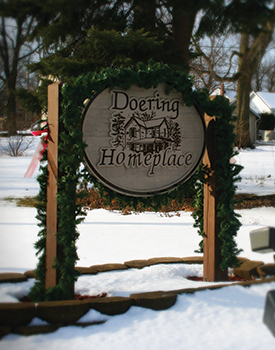
The East Peoria Historical Society seeks members, donations and contributions in revealing the city’s tales.
“What we do today is history tomorrow,” says Jim Zilch, vice president of the East Peoria Historical Society. Its mission is simple: to research, study and preserve the history of the East Peoria area.
In the late 1990s, former East Peoria Mayor Jim Spinder initiated the creation of East Peoria’s own historical society. With the help of former Chamber of Commerce director Dick Dodson, city attorney Dennis Triggs, James Healey and his wife, Barbara Doering Healey, Spinder’s idea became a reality in 1999.
The organization was formed upon the donation of the Doering Homeplace—built circa 1888—by the Healeys to the City of East Peoria to be used exclusively as a historical site; the neighboring building was also gifted to the city for use as a museum. The museum and homeplace are located at 324-326 Pekin Avenue; both sites are run by the East Peoria Historical Society.
Zilch calls the organization one of East Peoria’s best-kept secrets. “Many people don’t know the society exists, and those who do don’t realize the extent of the information available.” The museum, as well as the Fondulac District Library, houses many artifacts and documents relating to the city’s heritage.
Formerly known as Bluetown, Hilton and Coleville, East Peoria has an interesting history that’s often overshadowed. For instance, the Shelton Brothers—a Prohibition-era bootlegging gang famous for controlling gambling in Peoria—had a significant impact across the river as well. This untold story, among others, is one the organization would like to learn more about. Other stories, from details on the city's original site to the tract of land purchased by R.G. LeTourneau—where he hoped to create an entire subdivision of steel houses—to the ferries that carried traffic across the Illinois River before the first bridge opened in 1849 can be found on the society's website.
Its quarterly meetings, hosted at the Fondulac Park Building, are free and open to the public. Each features a different historical figure or topic of interest. The board of directors hopes to receive more feedback from the community about the specific people and topics about which the public would like to learn more.
Funds for maintaining the museum and home come from memberships and donations. While the East Peoria Historical Society has a solid membership base, it’s looking to expand that base to include the younger generations, who can provide new insights and ideas about how to preserve and share this history. In the future, it hopes to host tours of the city to highlight landmarks and other points of interest.
The society is always looking for information or items that hold significant value for telling the story of East Peoria. “We are all getting older each day of our life,” Zilch notes. “If we don’t capture the information we know now, it gets lost forever.” The East Peoria Historical Society will gladly accept and preserve any contribution to document the history of central Illinois. Items or information may pertain to schools, churches, local businesses, fraternal organizations, local government, youth organizations, unions and more. iBi
Tours of the Doering Homeplace and museum, by appointment only, can be scheduled by calling (309) 699-6755. For more on the history of East Peoria or the East Peoria Historical Society, visit eastpeoriahistoricalsociety.com.

